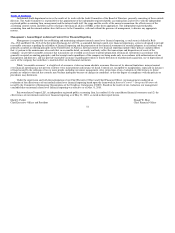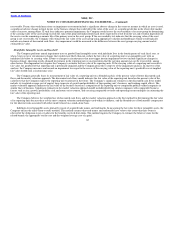Nike 2010 Annual Report Download - page 67
Download and view the complete annual report
Please find page 67 of the 2010 Nike annual report below. You can navigate through the pages in the report by either clicking on the pages listed below, or by using the keyword search tool below to find specific information within the annual report.
Table of Contents NIKE, INC.
NOTES TO CONSOLIDATED FINANCIAL STATEMENTS — (Continued)
See Note 9 — Income Taxes for further discussion.
Earnings Per Share
Basic earnings per common share is calculated by dividing net income by the weighted average number of common shares outstanding during the
year. Diluted earnings per common share is calculated by adjusting weighted average outstanding shares, assuming conversion of all potentially dilutive
stock options and awards.
See Note 12 — Earnings Per Share for further discussion.
Management Estimates
The preparation of financial statements in conformity with generally accepted accounting principles requires management to make estimates,
including estimates relating to assumptions that affect the reported amounts of assets and liabilities and disclosure of contingent assets and liabilities at the
date of financial statements and the reported amounts of revenues and expenses during the reporting period. Actual results could differ from these estimates.
Reclassifications
Certain prior year amounts have been reclassified to conform to fiscal year 2010 presentation, including a reclassification to investing activities for
the settlement of net investment hedges in the consolidated statement of cash flows for the year ended May 31, 2008. These reclassifications had no impact
on previously reported results of operations or shareholders’ equity and do not affect previously reported cash flows from operations, financing activities or
net change in cash and equivalents.
Recently Adopted Accounting Standards:
In January 2010, the Financial Accounting Standards Board (“FASB”) issued guidance to amend the disclosure requirements related to recurring and
nonrecurring fair value measurements. The guidance requires additional disclosures about the different classes of assets and liabilities measured at fair
value, the valuation techniques and inputs used, the activity in Level 3 fair value measurements, and the transfers between Levels 1, 2, and 3 of the fair
value measurement hierarchy. This guidance became effective for the Company beginning March 1, 2010, except for disclosures relating to purchases,
sales, issuances and settlements of Level 3 assets and liabilities, which will be effective for the Company beginning June 1, 2011. As this guidance only
requires expanded disclosures, the adoption did not and will not impact the Company’s consolidated financial position or results of operations. See Note 6
— Fair Value Measurements for disclosure required under this guidance.
In February 2010, the FASB issued amended guidance on subsequent events. Under this amended guidance, SEC filers are no longer required to
disclose the date through which subsequent events have been evaluated in originally issued and revised financial statements. This guidance was effective
immediately and the Company adopted these new requirements since the third quarter of fiscal 2010.
In June 2009, the FASB established the FASB Accounting Standards Codification (the “Codification”) as the single source of authoritative
U.S. GAAP for all non−governmental entities. The Codification, which launched July 1, 2009, changes the referencing and organization of accounting
guidance. The Codification became effective for the Company beginning September 1, 2009. The issuance of the FASB Codification did not change GAAP
and therefore the adoption has only affected how specific references to GAAP literature are disclosed in the notes to the Company’s consolidated financial
statements.
64
























